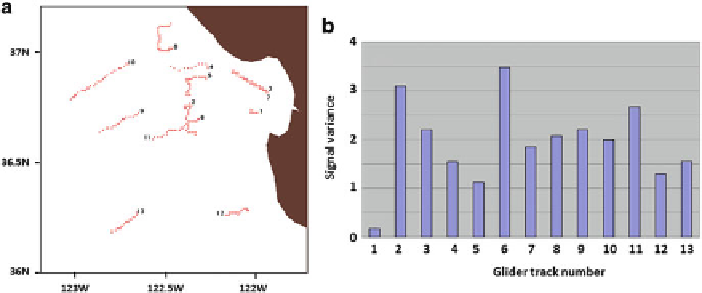Geoscience Reference
In-Depth Information
Fig. 16.8
(
a
) Glider tracks on Aug 13, 2003. (
b
) Signal variance summary bar chart for 13 glider
tracks shown in (
a
)
the verification time as a function of the glider track. It shows that, according to our
implementation of the ETKF, path 6 would have been the best followed by path 2
and 11.
16.6
Summary
The purpose of this Chapter is to illustrate the development and present preliminary
results of the ETKF ocean adaptive sampling system that incorporates three
distinctive techniques: (1) a time-shifting technique that enables an ensemble of very
high resolution atmospheric forecasts to be generated from a single high resolution
ensemble member, (2) an ET ensemble generation technique for the generation of
ocean ensemble, and (3) an ETKF technique for ocean adaptive sampling. The
system is applied to the Monterey Bay area during the AOSN II field campaign
in the month of August 2003.
The atmospheric forcing from COAMPS AOSN II forecast is shifted smoothly
in time to transfer a single deterministic forecast to an ensemble for ocean ensemble
forecast. The shifted atmospheric forcing fields are able to preserve the important
aspects of the atmospheric features so that each ocean ensemble member is forced
with an approximation to a realization of the true atmospheric state given previous
observations.
The NCOM ensemble mean is found to be able to give a better representation of
the upwelling features than the single deterministic run during the upwelling period.
Two upwelling centers are found. One is near the coast of Point Ano Nuevo and the
other near Point Sur. The ensemble mean is also found to be closer to the features
in the satellite observations than the ones in the control forecast. Furthermore,
the ensemble mean is closer to the observed cold water seaward movement and
transport across the mouth of the Monterey Bay during an earlier and later time of

Search WWH ::

Custom Search